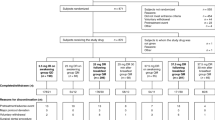Abstract
The pharmacokinetic profiles of a sustained-release monofluorophosphate (MFP-SR) preparation (76 mg) and of plain MFP (76 mg) were compared in six osteoporotic females. These studies were performed in a randomized, crossover, double-blind design to select a preparation that would result in therapeutic serum levels while avoiding high serum peak values. Following a single dose of 76 mg MFP-SR, the serum fluoride levels remained within the accepted therapeutic range (5–10 μM/liter) for 24 hours. In contrast, following a single dose of 76 mg plain MFP, serum fluoride levels exhibited a wide circadian fluctuation and serum levels approximately threefold higher than those of the MFP-SR preparation (9.5±1.6 vs 3.5±0.8 μM/liter, P<0.005). Compared with plain MFP, the sustained-release MFP had a significantly lower peak concentration (Cmax MFP-SR: 10.6 ±3 vs CmaxMFP: 18.9±5 μM/liter, P<0.005) and a significantly longer absorption lag time (TmaxMFP-SR 7.3±1.6 vs TmaxMFP: 3.0±0.6 h, P<0.05). Twenty-four-hour urinary fluoride excretion after ingestion of plain or SR fluoride was significantly increased from pretreatment values documenting absorption with either MFP formulation. Our results show that the use of sustained-release MFP preparation that we tested prevents the development of high peak levels associated with the use of plain MFP preparations. Furthermore, a single dose of MFP-SR resulted in serum fluoride levels within the accepted range of 5–10 μM/liter for 24 hours.
Similar content being viewed by others
References
Farley JR, Wergedal JE, Baylink DJ (1983) Fluoride directly stimulates proliferation and alkaline phosphatase activity of bone-forming cells. Science 222:330–332
Farley SM, Wergedal JE, Farley JR, Javier GN, Schulz EE, Talbot JR, Libanati CR, Lindegren L, Bock M, Goette M, Mohan SS, Kimball-Johnson P, Perkel VS, Cruise RJ, Baylink DJ (1992) Spinal fractures during fluoride therapy for osteoporosis: relationship to spinal bone density. Osteoporosis Int 2:213–218
Riggs BL, Hodgson SF, O'Fallon WM, Chao EYS, Wahner HW, Muhs JM, Cedel SL, Melton LJ (1990) Effect of fluoride treatment on the fracture rate in postmenopausal women with osteoporosis. N Engl J Med 322:802–809
Eriksen EF, Hodgson SF, Riggs BL (1988) Treatment of osteoporosis with sodium fluoride. In: Riggs BL, Melton LJ (eds) Osteoporosis etiology, diagnosis and management. Raven Press, New York, pp 415–432
Dambacher MA, Ittner J, Ruegsegger P (1986) Long-term fluoride therapy of postmenopausal osteoporosis. Bone 7:100–205
Delmas PD, Dupuis J, Duboeuf F, Chapuy MC, Meunier PJ (1990) Treatment of vertebral osteoporosis with disodium monofluorophosphate: comparison with sodium fluoride. J Bone Miner Res 5(suppl):143–147
Spak CJ, Sjoestedt P, Eleborg L, Veress B. Perbeck L, Ekstrand J (1989) Tissue response of gastric mucosa after ingestion of fluoride. Br Med J 298:1686–1687
Ericson Y (1983) Monofluorophosphate physiology: general considerations. Caries Res 17(suppl 1):46–55
Schnitzler CM, Solomon L (1986) Histomorphometric analysis of a calcaneal stress fracture: a possible complication of fluoride therapy for osteoporosis. Bone 7:100–205
Budden FH, Bayley TA, Harrison JE, Josse RG, Murray TM, Sturtridge WC, Kandel R, Vieth R, Strauss AL, Goodwin S (1988) The effect of fluoride on bone histology in postmenopausal osteoporosis depends on adequate fluoride absorption and retention. J Bone Miner Res 3(2):127–132
Lau K-HW, Farley JR, Freeman TK, Baylink DJ (1989) A proposed mechanism of the mitogenic action of fluoride on bone cells: inhibition of the activity of an osteoblastic acid phosphatase. Metabolism 38(9):858–868
Ekstrand J (1977) A micromethod for the determination of fluoride in blood plasma and saliva. Calcif Tissue Res 23:225–228
Van Kesteren RG, Duursma SA, Visser WJ, Van der Sluys Veer J, Backerdrinks O (1982) Fluoride in serum and bone during treatment of osteoporosis with sodium fluoride, calcium and vitamin D. Metab Bone Dis Rel Res 4:31–37
Taves DR (1970) New approach to the treatment of bone disease with fluoride. Fed Proc 29 (3):1185–1187
Hodge HC, Smith FA (1965) Effects of fluorides on enzyme systems. In: Simons HJ (ed) Fluorine chemistry. Academic Press, New York and London, pp 176–191
Lioté F, Bardin C, Liou A, Brouard A, Terrier JL, Kuntz D (1992) Bioavailability of fluoride in postmenopausal women: comparative study between sodium fluoride and disodium monofluorophosphate-calcium carbonate. Calcif Tissue Int 50: 209–213
Trautner K (1989) Influence of food on bioavailability of fluoride in man from Na2FPO3-containing tablets for the treatment of osteoporosis. Int J Clin Pharmacol Ther Toxicol 27(5):242–249
Sakhaee K, Pak CYC (1991) Fluoride bioavailability from immediate-release sodium fluoride with calcium carbonate compared with slow-release sodium fluoride with calcium citrate. Bone Miner 14:131–136
Author information
Authors and Affiliations
Rights and permissions
About this article
Cite this article
Resch, H., Libanati, C., Talbot, J. et al. Pharmacokinetic profile of a new fluoride preparation: Sustained-release monofluorophosphate. Calcif Tissue Int 54, 7–11 (1994). https://doi.org/10.1007/BF00316281
Received:
Accepted:
Issue Date:
DOI: https://doi.org/10.1007/BF00316281




